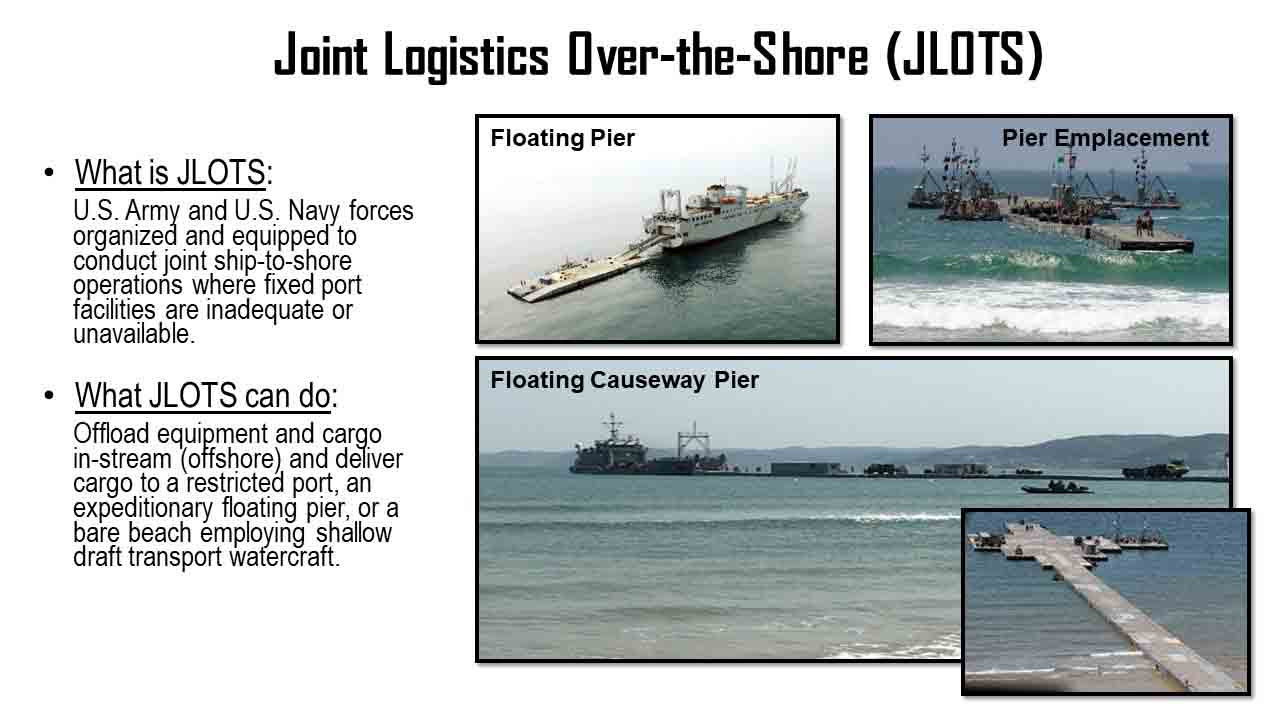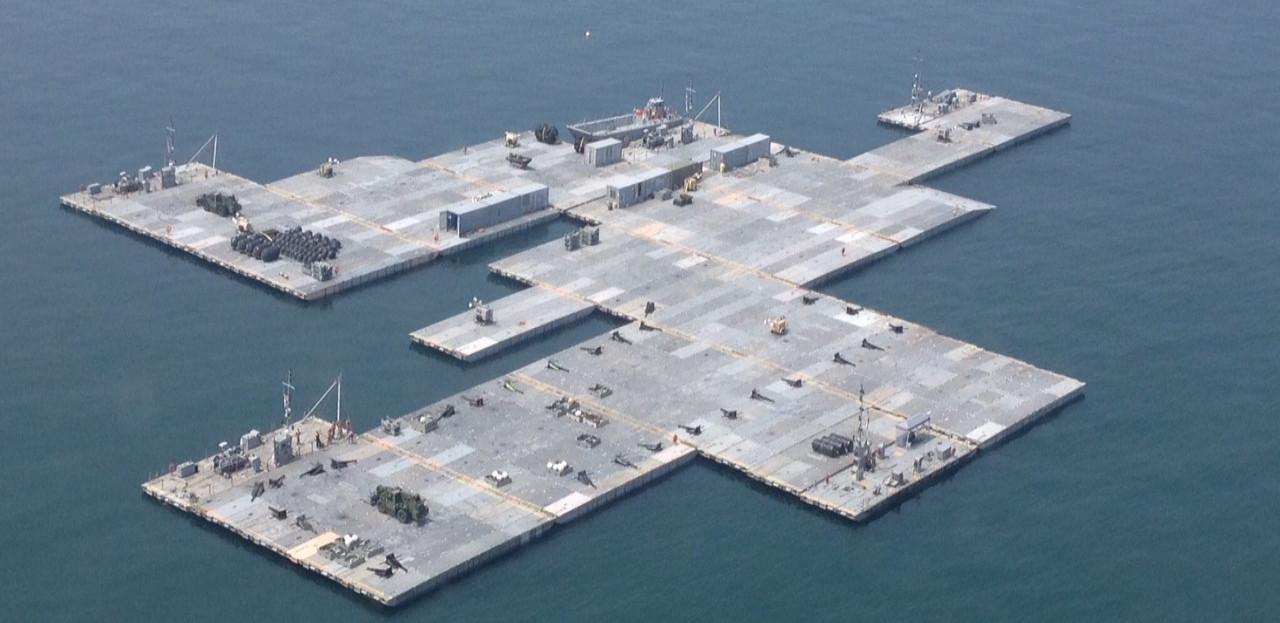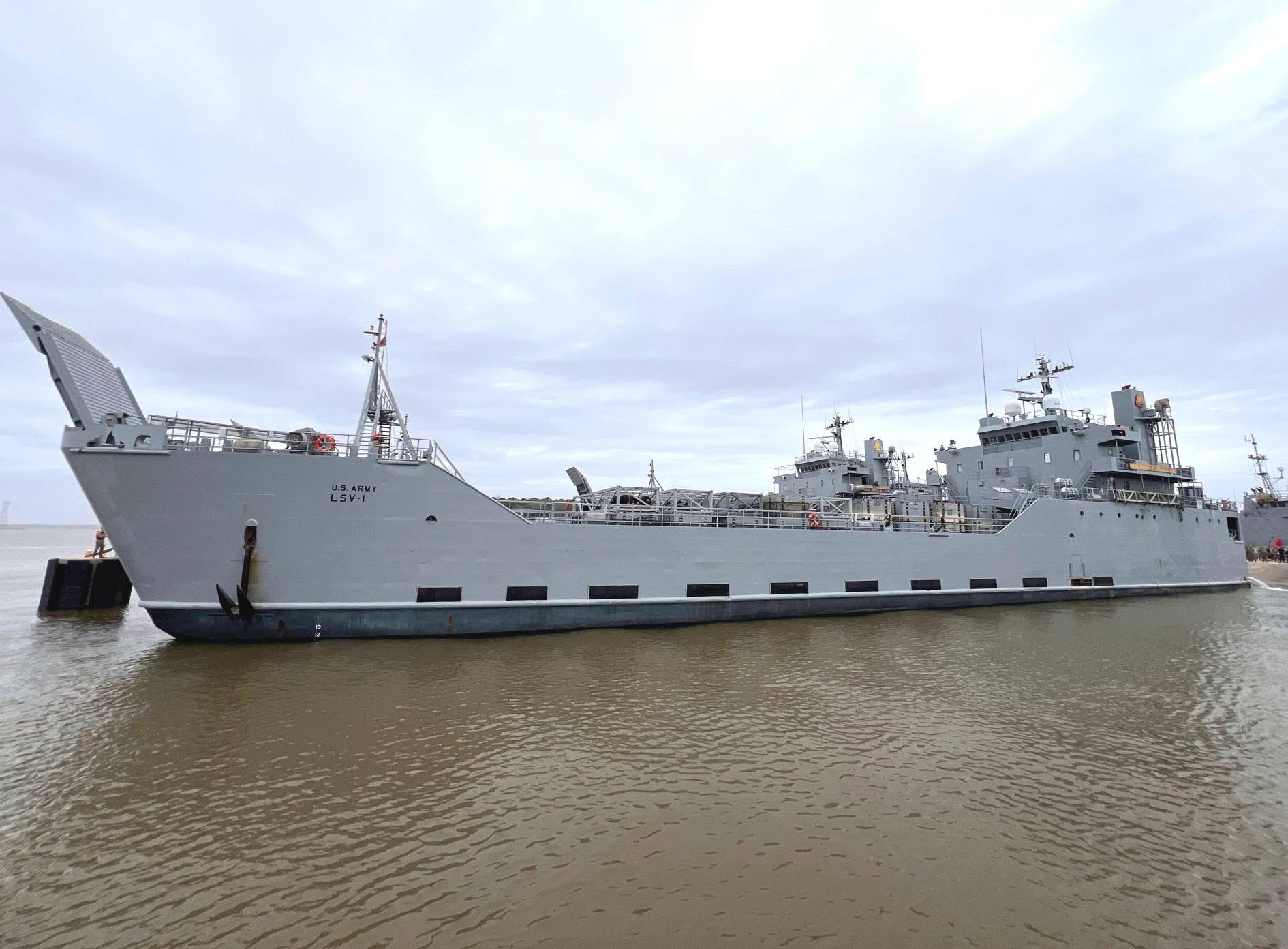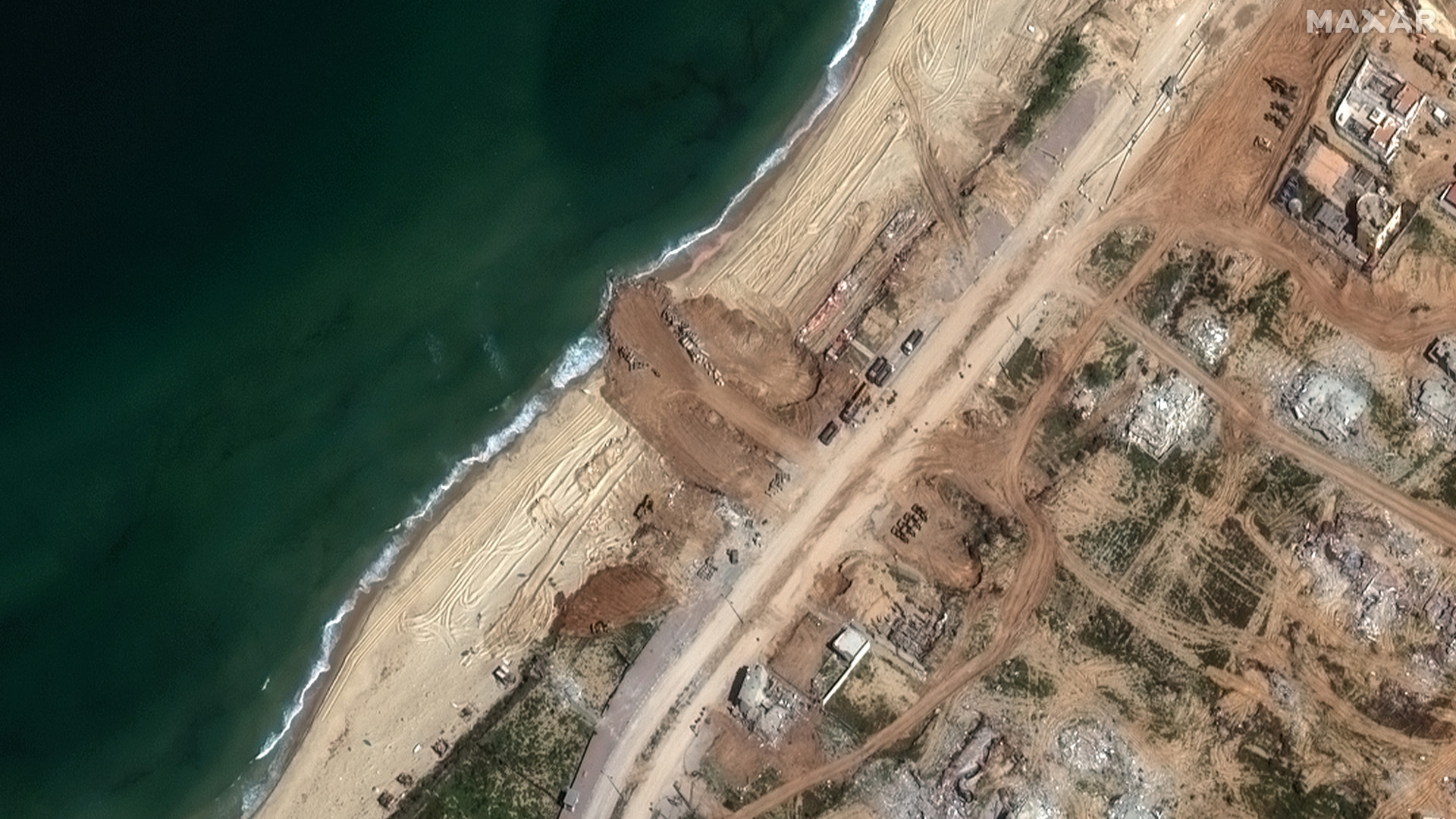Satellite imagery The War Zone has obtained from private firm Maxar shows the construction of a new jetty that looks to be part of a civilian maritime aid mission to the Gaza Strip. It’s not clear if the jetty could also be utilized in a larger U.S. military operation to establish a temporary pier to increase the flow of humanitarian assistance into Gaza, a construction effort that is expected to take up to 60 days. The War Zone previously explored the capabilities that could be utilized to put that plan into action, which you can find here.
Christiaan Triebert, a member of The New York Times‘ Visual Investigation team, was the first to share the trio of satellite images showing work on the jetty site, which is situated some three and a half miles southwest of Gaza City. The images were taken on March 11, March 12, and March 13. They show the reinforcement of the beach area before an extension measuring approximately 164 feet (50 meters) is built out into the water.



The jetty site is also near one end of a new road that Israel is building, variously called the Netzarim Road or the Netzarim Corridor, which runs east-west and effectively bisects Gaza.


Currently, the jetty looks to be linked to a pilot maritime aid mission to Gaza involving a civilian salvage ship named the Open Arms. The vessel left Cyprus on March 12 towing a barge with 200 tons of “flour, rice, and protein,” according to Reuters. That outlet has previously reported that this mission was on hold until the completion of “a makeshift jetty” being made “out of rubble.”
The United Arab Emirates (UAE) is reported to have provided the bulk of the funding for this aid. World Central Kitchen (WCK), a charity run by world-famous chef Jose Andres, together with a Spanish non-governmental organization (NGO) called Proactiva Open Arms, has been responsible for organizing the voyage and getting the jetty constructed.
What can be seen in the satellite images also aligns with a video showing dump trucks, cranes, and other construction equipment and materials moving toward Gaza’s shoreline. The clip was said to show work related to the U.S. military pier plan, but this may have actually been part of the work on this other jetty.
The voyage of the Open Arms looks to be the first test of a broader international initiative to establish a maritime aid corridor into Gaza.
“This maritime corridor can — and must — be part of a sustained effort to increase the flow of humanitarian aid and commercial commodities into Gaza through all possible routes,” reads a joint statement that the European Commission, the Republic of Cyprus, the UAE, the United Kingdom, and the United States put out on March 8. “We will continue to work with Israel to expand deliveries by land, insisting that it facilitate more routes and open additional crossings to get more aid to more people.”
This statement came a day after U.S. President Joe Biden first announced the U.S. military would be establishing a larger temporary pier to help get aid into Gaza during his annual State of the Union speech.
The U.S. military’s plan, as it has publicly described so far, centers around the use of a family of U.S. Army and U.S. Navy-managed logistical capabilities collectively known as Joint Logistics Over-The-Shore (JLOTS). JLOTS was among the things that The War Zone highlighted in our earlier story about how American forces might carry out this mission after news of it first emerged last week.

“Simply put, they’ll establish a temporary offshore maritime pier that allows for … [larger] vessels to transfer cargo to smaller vessels to transport and offload cargo to a temporary causeway for the delivery of humanitarian aid to Gaza,” Air Force Maj. Gen. Pat Ryder, the Pentagon’s top spokesman, said at a press conference on March 8.

Whether the U.S. military will make use of the new jetty, too, is unclear. Broadly similar work will be required to help link the causeway to the shore.
The humanitarian aid will be staged at another location first before being transported to the temporary off-shore pier, and then transferred to the causeway. Cyprus has been widely viewed as the most likely initial staging site, which is supported by the WCK maritime aid mission that is happening now. This island nation occupies a highly strategic position in the eastern Mediterranean Sea that the U.S. and other foreign militaries have long used as a key staging location for contingency operations in the region. It also hosts a British air base.
The Pentagon estimates that when its temporary pier is up and running, it will have the capacity to bring “2,000,000 humanitarian aid meals per day” into Gaza. However, getting the operation fully underway will take time.
“We anticipate that it’ll take over 1,000 U.S. forces to participate in building this capability,” Maj. Gen. Ryder said at the March 8 press conference. “As far as timeframe, as I mentioned, several weeks, likely up to 60 days in order to deploy the forces and construct the causeway and the pier.”
What units will supply all of those forces is not entirely clear. The Pentagon initially only identified the U.S. Army’s 7th Transportation Brigade (Expeditionary), the service’s premier JLOTS unit based at Joint Base Langley-Eustis in Virginia, as being involved in the operation, which U.S. Central Command (CENTCOM) is overseeing.
The involvement of the 7th Transportation Brigade has, in turn, shone a new light on the Army’s obscure and largely underappreciated watercraft fleets, which include various types of landing craft and larger ships known as Logistics Support Vessels (LSV). You can read more about these vessels in detail here.

One of the Army’s LSVs, the USAV General Frank S. Besson Jr., left Joint Base Langley-Eustis on March 9. Another one of these ships, of which the service only has eight in total, USAV SP4 James A. Loux, departed on March 12. The Besson and the Loux are part of the initial batch of six LSVs, which all displace around 4,200 tons. The service also has a subclass of two additional LSVs that feature significant changes to the core design. This most notably includes a more hydrodynamic bow that gives them improved performance during longer-duration operations on open seas.
A trio of smaller, LCU 2000 class landing craft, the USAV Matamoros, the USAV Montorrey, and the USAV Wilson Wharf, also left their homeport in Virginia on March 12 together with the Loux.
The Pentagon has said that the LSVs could be among the assets used to transfer humanitarian aid from the floating pier offshore to the causeway actually connected to Gaza’s coastline. The LCU 2000s would also be useful in this capacity. The LSVs could also help move larger amounts of cargo from the initial staging area to the pier.
Some years ago, the Army looked to be at risk of losing a significant portion of its watercraft capabilities, something The War Zone followed very closely. The service has since reversed course and is now pursuing new and expanded watercraft capabilities, with a particular focus on how these assets might contribute to a potential major conflict in the Pacific against China.
When it comes to the current operation to help get aid into Gaza, beyond the Army assets, the Navy will be contributing the M/V Roy P. Benavidez, a Bob Hope class roll-on/roll-off cargo ship that displaces just over 62,000 tons with a full load, as well as elements of Naval Beach Group 1, according to USNI News.
Benavidez was a Navy ship until 2022, when it left service and became a part of the Ready Reserve Force (RRF) that is managed by the Department of Transportation’s Maritime Administration (MARAD). When activated, RRF ships come under the operation control of the Navy’s Military Sealift Command (MSC). This ship could also support the initial movement of aid to the floating pier.

When it comes to Naval Beach Group 1, which is based in San Diego, this “is the sole Navy unit to conduct Improved Navy Lighterage System (INLS) missions,” the Navy said in a statement to USNI News. “The INLS is a causeway system that resembles a floating pier comprised of interchangeable modules and is used to transfer cargo from ships to shore areas where conventional port facilities are unavailable or inadequate.”
INLS, the primary component of which is rectangular modular floating platforms that can be configured in various ways, is a JLOTS capability.

Other elements of the Army and Navy, as well as personnel from relevant units elsewhere within the U.S. military, could also end up taking part in this operation, which is still in its very early stages.
So far, the Pentagon insists that the temporary pier operation will not require U.S. forces to actually go ashore in Gaza. There are also no indications one way or another about what force protection measures may be implemented to protect American personnel who will be operating close to what is a very active conflict zone. Hamas and other extremist groups have artillery rockets and anti-tank guided missiles at their disposal that can put ships even thousands of feet off the beach at risk. There is also the possibility of massive crowds which could be a huge problem for safely conveying the cargo. The IDF’s participation in force protection would seem critical for this operation, but it isn’t clear on what level they will participate.
“We’re working through the details right now with partners in the region, to include Israel, in terms of the security aspect,” Maj. Gen. Ryder said on March 8. “Then … [we’ll be] working with ally and partner nations, working with the U.N. [United Nations], working with NGOs to discuss the actual aid distribution piece.”
Broader questions and criticism about the feasibility and utility of this operation, which by the Pentagon’s own estimates may not be fully in swing until sometime in June, have already been raised. Getting humanitarian aid into Gaza using traditional ground convoys has been a serious and controversial issue since the very opening stages of the conflict, which erupted after Hamas and other groups launched unprecedented attacks on southern Israel on October 7, 2023. The United Nations’ World Food Program (WFP) announced on Tuesday that it had been able to get its first aid convoy into northern Gaza in some three weeks.
A growing number of countries, including the United States, have already resorted to air-drops, a costly and generally low-volume means of delivering aid that has historically been described as a last-resort option.

It remains to be seen how much aid will ultimately flow through the maritime corridor that is in the process of being established now, and how soon that route may be truly viable. The larger questions around the security of such an operation remain unanswered. Still, the emergence of the new pier, which looks set to receive the first aid shipment by sea soon, shows that work is being done to open up this additional much-needed stream of assistance to Gaza’s residents.
Contact the author: joe@twz.com
